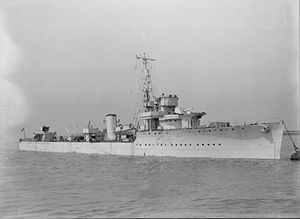
HMS Javelin was a J-class destroyer of the Royal Navy.

HMS Wryneck was an Admiralty W-class destroyer of the Royal Navy, which was sunk during the Battle of Greece on 27 April 1941.

The Admiralty type leader, sometimes known as the Scott class, were a class of eight destroyer leaders designed and built for the Royal Navy towards the end of World War I. They were named after Scottish historical leaders. The function of a leader was to carry the flag staff of a destroyer flotilla, therefore they were enlarged to carry additional crew, offices and signalling equipment, allowing a fifth gun to be carried. These ships were contemporary with the Thornycroft type leader, distinguishable by their two narrow funnels of equal height, the Thornycroft designs latter having characteristic broad, slab-sided funnels.

HMS Vansittart was an Admiralty modified W-class destroyer built for the Royal Navy. She was ordered in January 1918 from William Beardmore & Company with the 13th Order for Destroyers of the Emergency War Program of 1918–19. She was the second Royal Navy ship to carry the name which was first used in 1821 for a hired packet.

The Derzky or Bespokoiny-class destroyers was a class of destroyers built for the Imperial Russian Navy just before World War I. Nine ships were built for the Black Sea Fleet. These ships were a derivative of the Novik, but were slightly smaller. These ships were popular with the Russians and effective particularly in the Black Sea, where the Ottoman Navy had no similar ships.
The Izyaslav class were a class of destroyers built for the Baltic Fleet of the Imperial Russian Navy. They were modified versions of the Orfey class built in Russia with the assistance of the French company Augustin Normand. These ships fought in World War I, the Russian Civil War, the Estonian War of Independence, and World War II.

HMS Winchelsea (D46) was an Admiralty W-class destroyer of the Royal Navy, ordered 9 December 1916 from J. Samuel White at Cowes during the 1916–17 Build Programme.

HMS Woolston was a W-class destroyer of the Royal Navy. She served through two world wars, surviving both of them.

HMS Verity was an Admiralty modified W-class destroyer built for the Royal Navy. She was the first ship to carry the name Verity. She was ordered in January 1918 from John Brown & Company of Clydebank with the 13th Order for Destroyers of the Emergency War Program of 1918–19.
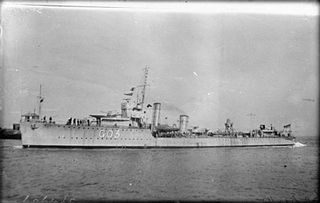
HMS Vortigern was a V-class destroyer of the Royal Navy. She served in both World Wars, and was sunk in 1942.
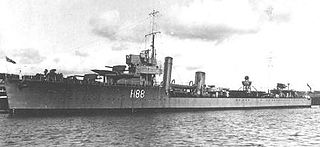
HMS Wakeful was a W-class destroyer of the Royal Navy, built under the 1916–1917 Programme in the 10th Destroyer order. Wakeful was assigned to the Grand Fleet after completion, and served into the early years of the Second World War. Wakeful was torpedoed and sunk during Operation Dynamo by a German E-Boat on 29 May 1940.
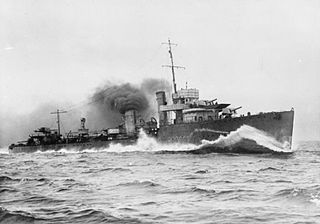
HMS Vimiera was a V-class destroyer ordered as part of the 1917–18 programme.

The first HMS Whirlwind was a W-class destroyer of the British Royal Navy that saw service during World War I and World War II.

HMS Wolfhound was one of 21 W-class destroyers built for the Royal Navy during the First World War. Completed in 1918 the ship only played a minor role in the war before its end. The ship was converted into an anti-aircraft escort destroyer during the Second World War and was badly damaged during the Dunkirk evacuation. Wolfhound survived the war and was sold for scrap in 1948.
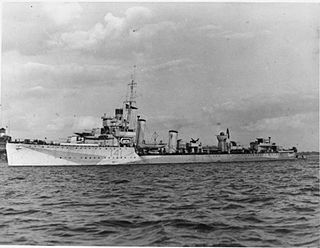
HMS Walpole (D41) was a W-class destroyer of the Royal Navy.

HMS Wren (D88/I88) was an Admiralty modified W class destroyer built for the Royal Navy. She was ordered in April 1918 from Yarrow Shipbuilders Limited under the 13th Order for Destroyers of the Emergency War Program of 1918–19. She was the third Royal Navy ship to carry the name, which was introduced in 1653.
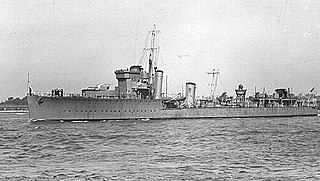
HMS Whitley (L23), ex-Whitby, was a W-class destroyer of the British Royal Navy that saw service in the British campaign in the Baltic Sea against Bolshevik forces during the Russian Civil War and in the early months of World War II.

HMS Winchester was an Admiralty W-class destroyer of the Royal Navy. She saw service in the First and Second World Wars.

The first HMS Walrus (D24) was a W-class destroyer of the British Royal Navy that saw service in the final months of World War I.
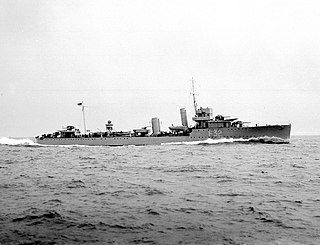
The first HMS Wessex (D43) was a W-class destroyer of the British Royal Navy that saw service in the final months of World War I and the early months of World War II.
This page is based on this
Wikipedia article Text is available under the
CC BY-SA 4.0 license; additional terms may apply.
Images, videos and audio are available under their respective licenses.
